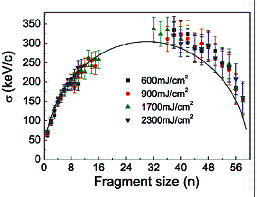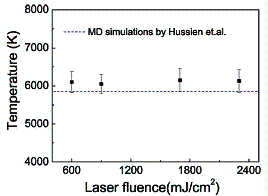The momentum distributions of the prompt ionic fragments Cn+ (n≤58)were measured in the fragmentation of C60 with nanosecond laser excitation by utilizing the atom-ion laser experimental platform in Institute of Modern Physics(IMP), CAS.
The momentum widths at various laser fluences versus the fragment mass show a same behavior, as shown in Fig. 1. The “Goldhaber model” used in nuclear fragmentation, for the first time, has been extended to extract the excitation temperature of fragmented C60 from the momentum widths. It was found that all fragmented C60 which appear as prompt ionic fragments have almost the same temperature and the temperature has no significant variation with laser fluences in our limited range.
The results provide a clear evidence that a first-order phase transition in the fragmented C60 is occurring at this temperature. The phase transition temperature is found to be about 6050K ± 250K, which is in a good agreement with the most recent estimations based on the molecular dynamics simulation, see the Fig. 2.
The momentum distributions of the prompt ionic fragments can be used as a novel molecular thermometer and be applied to other complex systems.It may offer new experimental opportunities for studying the fragmentation phase transition of complex polyatomic molecules under excitation temperature determined conditions.
The results were published in Physical Chemistry Chemical Physics 13 (2011)3328.
The link to the paper: http://pubs.rsc.org/en/Content/ArticleLanding/2011/CP/c0cp00773k

Fig.1 Momentum widths at various laser fluences as a function of fragment mass in carbon atomic mass units(Image by Institute of Modern Physics)

Fig.2 Excitation temperatures measured from themomentum distribution widths of all fragments versus laser fluences(Image by Institute of Modern Physics)

